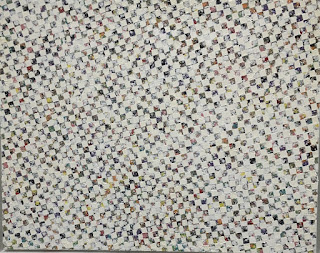James Little - Black Stars and White Paintings
Kavi Gupta Gallery
************
Spangled Star, 2022, 72"x72"
Calculated Risk, 64" x 74", 2022
detail
A Review of James Little - Black Stars and White Paintings at Kavi Gupta
*********
Down in Memphis, the patterns of colored stripes in his first museum show of the year was typical of his work. They’re as emotion free as a page torn from a book of color theory. There isn’t even a sense of wonder, balance, or humor. Just the pure, unfiltered energy of a technical investigation.
But when his monumental “Black Stars” are shown beside his perforated “White Paintings”, the game changes. The black stars exemplify the drive and singularity of purpose that’s still required for blacks to rise above the dark legacy of oppression. The rows of regularly spaced tiny windows into his white paintings reveal an apparently limitless variety of colorful, sensual miniatures - like the urban grid of a trendy white neighborhood where every high rent condo shelters someone’s unique opportunity for self gratification. The artist acknowledges this racial binary in this exhibit, but also tells us “That whole racial aspect isn’t any more important to me than trying to paint some emblematic arrangements with two tones of black.” - so this may be the last time he crosses over into racial stereotypes - even though it would not hurt his career. These same black and white paintings were probably what got him into the Whitney Biennial this year - his first appearance ever.
Minimalism and racial conceptual art appear to have accidentally collided, and the results are far more compelling than either of those genres by themselves. Likewise, the white paintings in this show are more interesting because of the black ones nearby - and vice versa. Together they tell a story that’s personal, national, and cosmic — all at the same time. And it does feel more more important than the artist’s less referential work. More seems to be at stake: social harmony instead of the private isolation.
******
note: the
New City Review tells us that the artist is "deeply committed to portray the challenges, complexities and possibilities of the Black experience, through the expressive capabilities of abstraction" -- but Black identity is more in the mind of the reviewer than the artist. His own words, as well as his forty year career as an abstract painter, tell a different story..




No comments:
Post a Comment